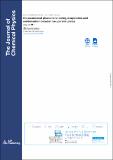| dc.contributor.author | Chen, Gang | |
| dc.date.accessioned | 2024-09-19T19:28:28Z | |
| dc.date.available | 2024-09-19T19:28:28Z | |
| dc.date.issued | 2023-10-21 | |
| dc.identifier.uri | https://hdl.handle.net/1721.1/156907 | |
| dc.description.abstract | Kinetic theory has long predicted that temperature inversion may happen in the vapor-phase for evaporation and condensation between two parallel plates, i.e., the vapor temperature at the condensation interface is higher than that at the evaporation interface. However, past studies have neglected transport in the liquid phases, which usually determine the evaporation and condensation rates. This disconnect has limited the acceptance of the kinetic theory in practical heat transfer models. In this paper, we combine interfacial conditions for mass and heat fluxes with continuum descriptions in the bulk regions of the vapor and the liquid phases to obtain a complete picture for the classical problem of evaporation and condensation between two parallel plates. The criterion for temperature inversion is rederived analytically. We also prove that the temperature jump at each interface is in the same direction as externally applied temperature difference, i.e., liquid surface is at a higher temperature than its adjacent vapor on the evaporating interface and at a lower temperature than its adjacent vapor on the condensing interface. We explain the interfacial temperature jump and temperature inversion using the interfacial cooling and heating processes, and we predict that this process can lead to a vapor phase temperature much lower than the lowest wall temperatures and much higher than the highest wall temperature imposed. When the latent heat of evaporation is small, we found that evaporation can happen at the low temperature side while condensation occurs at the high temperature side, opposing the temperature gradient. | en_US |
| dc.language.iso | en | |
| dc.publisher | AIP Publishing | en_US |
| dc.relation.isversionof | 10.1063/5.0171205 | en_US |
| dc.rights | Creative Commons Attribution | en_US |
| dc.rights.uri | https://creativecommons.org/licenses/by/4.0/ | en_US |
| dc.source | AIP Publishing | en_US |
| dc.title | On paradoxical phenomena during evaporation and condensation between two parallel plates | en_US |
| dc.type | Article | en_US |
| dc.identifier.citation | Gang Chen; On paradoxical phenomena during evaporation and condensation between two parallel plates. J. Chem. Phys. 21 October 2023; 159 (15): 151101. | en_US |
| dc.contributor.department | Massachusetts Institute of Technology. Department of Mechanical Engineering | en_US |
| dc.relation.journal | The Journal of Chemical Physics | en_US |
| dc.type.uri | http://purl.org/eprint/type/JournalArticle | en_US |
| eprint.status | http://purl.org/eprint/status/PeerReviewed | en_US |
| dc.date.updated | 2024-09-19T19:22:55Z | |
| dspace.orderedauthors | Chen, G | en_US |
| dspace.date.submission | 2024-09-19T19:23:00Z | |
| mit.journal.volume | 159 | en_US |
| mit.journal.issue | 15 | en_US |
| mit.license | PUBLISHER_CC | |
| mit.metadata.status | Authority Work and Publication Information Needed | en_US |
